#emiratos
Explore tagged Tumblr posts
Text
🔴AHORA: Inundaciones y lluvias extremas en Emiratos Árabes Unidos
106 notes
·
View notes
Text
Fernando Boudourian: destinos sólidos para patrimonios móviles

Lisboa ajusta su régimen fiscal. Dubái es epicentro de riqueza global. Montevideo brinda confianza. Tres respuestas distintas a una misma tendencia.
0 notes
Text
FUNDACION EMERITO Lo que Pablo Motos no preguntó a Victoria Federica en El Hormiguero, por @ErnestoEkaizer Otro cachondeo. Un rey emérito de España con fundación en Emiratos para no pagar a Hacienda y ocultar a los herederos. Video publicado por Jesús Cintora @JesusCintora
#fundacion#emiratos#dinerooculto#emerito#reyjuancarlos#herederas#infantas#paraisosfiscales#VictoriaFederica#ElHormiguero#carabanchel#madrid
1 note
·
View note
Text

D U B A I
61 notes
·
View notes
Text
10th part of the bookscans of Al Andalus. Historical Figures, here's the previous part
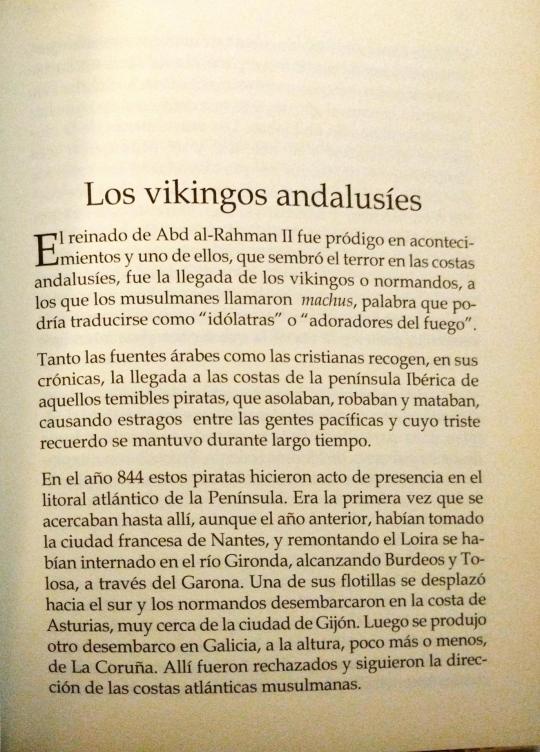
The Andalusian Vikings
The reign of Abd al-Rahman II was rich in events and one of them, that spread terror on the Andalusian coasts, was the arrival of the Vikings or Normans, whom the Muslims called machus, a word that could translate as “idolaters” or “fire worshipers.”
Both Arab and Christian sources record, in their chronicles, the arrival to the coasts of the Iberian Peninsula from those fearsome pirates, who devastated, robbed and killed, wreaking havoc among the peaceful people and whose sad memory remained for a long time.
In the year 844 these pirates made an appearance on the Atlantic coast of the Peninsula. It was the first time they had come there, although the year before, They had taken the French city of Nantes, and going up the Loire they had entered the Gironde River, reaching Bordeaux and Toulouse, through the Garonne.
One of their fleets moved south and the Normans landed in the coast of Asturias, very close to the city of Gijón. Then there was another disembark in Galicia, at the height, more or less, of A Coruña. There they were rejected and followed the direction of the Muslim Atlantic coasts.
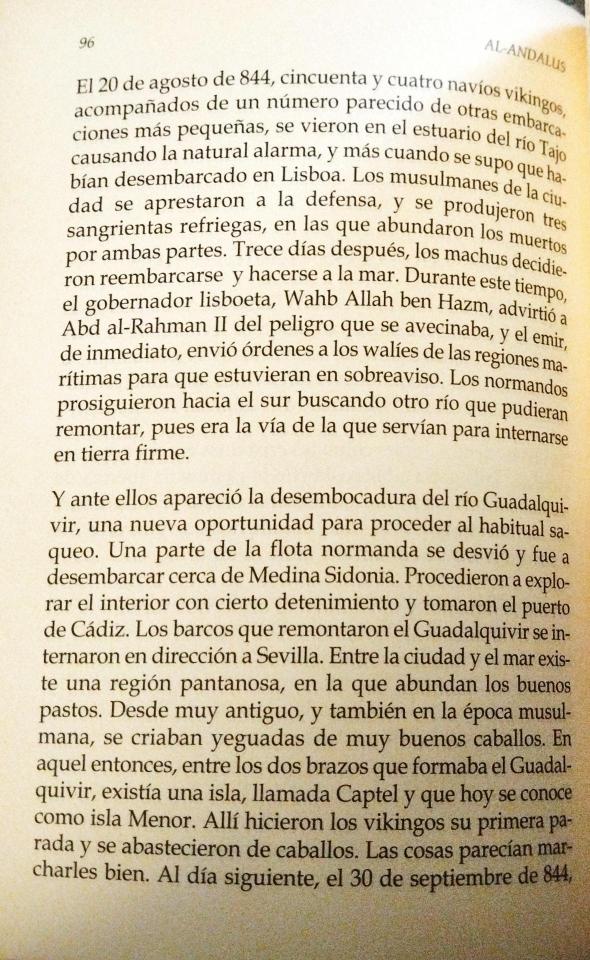
On August 20, 844, fifty-four Viking ships, accompanied by a similar number of other smaller vessels were seen in the estuary of the Tagus River causing natural alarm, and even more so when it was learned that they had landed in Lisbon. The Muslims of the city prepared the defense, and there were three bloody skirmishes, in which there were many dead on both sides. Thirteen days later, the Machus decided reembark and put to sea. During this time, the Lisbon governor, Wahb Allah ben Hazm, warned Abd al-Rahman II of the danger ahead, and the emir immediately sent orders to the walis of the maritime regions so that they were on notice. The Normans continued south looking for another river that they could go up, since it was the route they used to go into dry land.
And before them appeared the mouth of the Guadalquivir river, a new opportunity to proceed with the usual looting. A part of the Norman fleet diverted and landed near Medina Sidonia. They proceeded to explore the interior at some length and took the port of Cádiz. The ships who went up the Guadalquivir headed towards Seville. Between city and the sea there is a swampy region, in which there are good pastures. Since ancient times, and also in Muslim times, they were raised studs of very good horses. Back then, between the two arms that formed the Guadalquivir, there was an island, called Captel and which today is known as Minor Island. There the Vikings made their first stop and supplied themselves of horses. Things seemed to be going well. The next day, the 30th September 844,

Four ships reached the town of Coría del Río, located about four kilometers away from Captel. They disembarked, proceeded to total looting and murdered the population, in one of their typical performances.
Three days later the Norman fleet. continued upriver and before the frightened eyes of the Sevillians, the black sails of the pirate ships appeared. The sad fate of the inhabitants of Coria del Río was known, and the terrified citizens rushed to organize themselves to resist, but the governor, no more scared than the others!, had fled towards Carmona. Lacking direction, they did what they could, sending to meet the machus' fleet some ships, which were received with a shower of incendiary arrows and they all burned without any possibility of defense.
Seville was evacuated as quickly as possible, although not everyone left the city, some because of their health status, others because they are elderly and others because they did not want to abandon their property, a useless precaution, since the Vikings, landing in Seville, killed them all. Women and children were taken captive, while a horrific looting of the city was carried out, which lasted seven days.
So much loot was obtained that the Norman ships were overcrowded, so much of wealth and of frightened Muslim women who did not know what was going to happen to them in the hands of those barbarians from the north. They decided to return to base that they had established in Captel and disembark everything they had achieved, it was impossible to continue sailing with such an abundant and precious cargo.
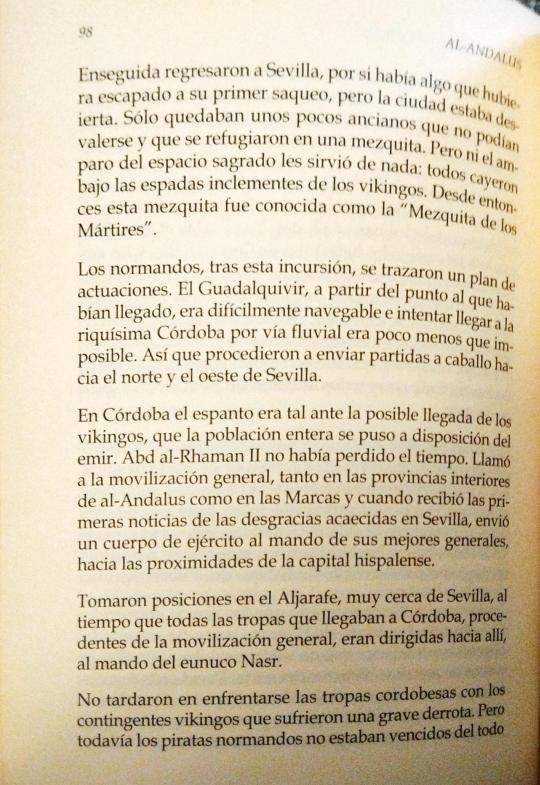
They immediately returned to Seville, in case there was anything that had escaped their first looting, but the city was deserted. There were only a few old people left who did not could help themselves and took refuge in a mosque. But not even the protection of sacred space was of no use to them: they all fell under the merciless swords of the vikings. Since then this mosque was known as the "Mosque of the Martyrs".
The Normans, after this raid, drew up a plan of action. The Guadalquivir, from the point they had reached, was difficult to navigate and trying to reach the rich Córdoba by river was almost impossible. So they proceeded to send horse parties to the north and west of Seville.
In Córdoba the fear was such at the possible arrival of the Vikings, that the entire population was placed at the disposal of the emir. Abd al-Rhaman II had not lost time. He called for general mobilization, both in the interior provinces of Al Andalus and in the Marches and when he received the first news of the misfortuned events in Seville, he sent an army under the command of his best general, towards the outskirts of the capital of Seville.
They took up positions in Aljarafe, very close to Seville, while all the troops arriving in Córdoba, from the general mobilization, were headed there, under the command of the eunuch Nasr.
It didn't take long for the Cordoban troops to clash with the Viking contingents that suffered a serious defeat. But still the Norman pirates were not completely defeated
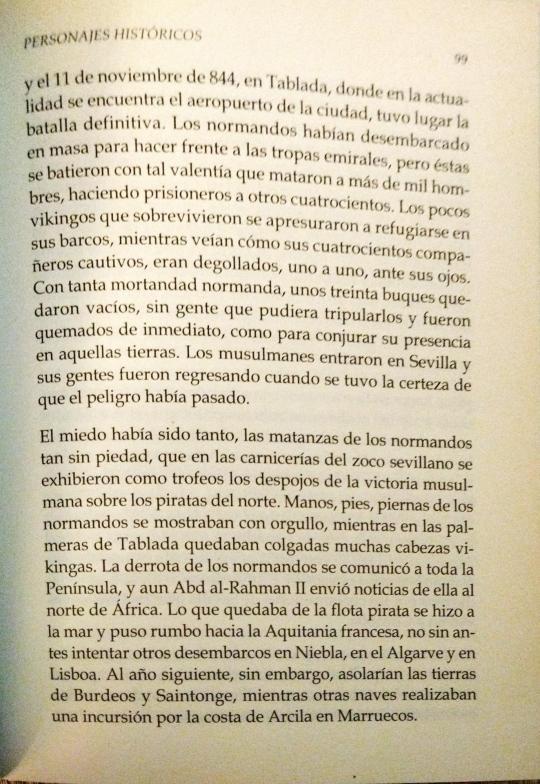
and on November 11, 844, in Tablada, where the city airport is nowadays located, the final battle took place. The Normans had landed en masse to confront the emiral troops, but they fought with such bravery that they killed more than a thousand men, taking prisoners to another four hundred. The few Vikings who survived rushed to take refuge in their ships, while they saw how their four hundred companions captives, their throats were beheaded, one by one, before their eyes. With so much Norman mortality, about thirty ships were left empty, without people who could man them and they were burned immediately, as if to ward off their presence in those land. The Muslims entered Seville and its people returned when it was certain that the danger had passed.
The fear had been so great, the massacres of the Normans so mercilessly, that in the butcher shops of the Sevillian souk, the remains of the Muslim victory over the northern pirates were shown as trophies. Normans hands, feet, legs, were showed with pride, while in the palm trees of Tablada many Viking heads were left hanging. The defeat of the Normans was communicated to the entire Peninsula, and even Abd al-Rahman II sent news of it to North Africa. What remained of the pirate fleet put to sea and headed towards the French Aquitaine, but not before attempting other landings in Niebla, in the Algarve and in Lisbon. The following year, however, they would ravage the lands of Bordeaux and Saintonge, while other ships made a raid along the coast of Asilah in Morocco.

Up to this point this could be the story of the Norman adventures in the 9th century along the Andalusian coasts, but the story continues in an amazing way. The hasty flight of the Machus after the defeat of Tablada did not allow some groups of Normans to be collected, whichwere left on land and without any possibility of reembarking. Alone and without possible help, these groups dispersed through Carmona and Morón. Their presence filled the inhabitants of these lands with dread, although its potential for attack was extremely small, and the Umayyad general Muhammad ben Rustum, one of Tablada's heroes, went out to fight them. They had no more choice but to surrender, in exchange for saving one's life, which was no small thing, after their barbaric actions.
What to do in a strange land, so far from the Nordic mists and the women with blonde hair? The surviving Normans opted for a practical solution. Those men who only knew how to navigate, kill and loot, they were not going to join the emir's military forces, no, not at all. They converted to Islam, changed Thor and Odin for Allah and Muhammad, and in the lower valley of the Gudalquivir they dedicated themselves to cattle raising, and to milk industry! Those muladíes, converted into authentic Andalusians, made cheeses of extraordinary quality, greatly appreciated by consumers from Seville that were even sent to Córdoba.
That's how amazing life and history can be. Who was going to tell those brave Normans, when they left their distant lands, which at the end of their trip they would end up becoming Muslims and cheese makers!
#al andalus historical figures#al andalus personajes históricos#book scans#bookblr#historyblr#al andalus#al andalus history#emirate of cordoba#emirato de córdoba#history#andalusian vikings#vikingos andalusíes#spanish history#muhammad ibn rustum#nars#abd al rahman ii#abd al rahman ii of córdoba#nars abul-fath
14 notes
·
View notes
Text
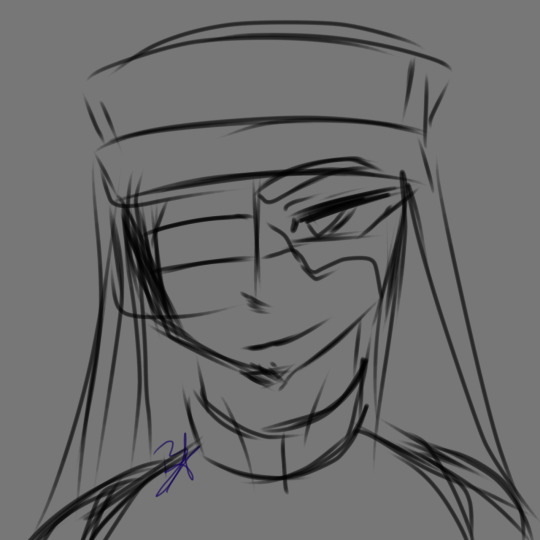
I have two sides
🇦🇪 ✨/🇦🇪💲

3 notes
·
View notes
Text
Qué necesito para viajar a los Emiratos Árabes Unidos
Descubre los requisitos para viajar a Emiratos Árabes Unidos: visa, pasaporte, vacunas y más. Prepárate sin complicaciones.
Leer todos los detalles - https://www.travelogyviajes.com/blog/que-necesito-para-viajar-a-los-emiratos-arabes-unidos
#paquetes de viaje india#Emiratos Árabes#Travelogy Viajes#viaje a Dubai#Paquetes turísticos de Dubai
0 notes
Text
TRUMP General de División (R.) Rafael Dávila Álvarez
La guerra es inevitable. Perdonen la dureza del comienzo. Los signos son reveladores. Habrá guerra. Es tal el estado de cosas heredadas de la política emprendida por un presidente (Obama) que quiso entretenerse con la política como si fuese el conocido juego de las canicas que metió en un hoyo profundo a la cultura occidental. Desaparecida. Quizá sea mejor. Las vacas no comen si no las cambias…

View On WordPress
#Afganistán#america first#biden#Blog: generaldavilaa.com#el petróleo#Emiratos Árabes Unidos y Catar#Europa y la OTAN de Biden querían la guerra#General de División (R.) Rafael Dávila Álvarez#hombrecillos de verde#Irak y Siria#la otan#la retirada de afganistan#los aranceles#los dólares junto a los petrodólares y el yuan#Obama#Onosandro. Estratégico#premio nobel de la paz#Trump#Trump en Arabia Saudita#Zelenski
0 notes
Photo

PRIMA PAGINA Marca di Oggi giovedì, 15 maggio 2025
#PrimaPagina#marca quotidiano#giornale#primepagine#frontpage#nazionali#internazionali#news#inedicola#oggi emirato#suspiro#obliga#quiere#contar#lanes
0 notes
Text
Limpieza de edificios mediante tecnología de drones en Emiratos Árabes Unidos:
60 notes
·
View notes
Text





Arriba y adelante: El pasado 10 de enero, el equilibrista Jaan Roose caminó en una cuerda floja entre las dos Torres Emirates de Dubai. El recorrido de Rosse fue de 100 metros a 224 metros de altura. [x]
0 notes
Video
youtube
OS DOIS REIS E OS DOIS LABIRINTOS
0 notes
Text

BURJ KHALIFA
71 notes
·
View notes
Text
9th part of the bookscans of Al Andalus. Historical Figures, here's the previous part
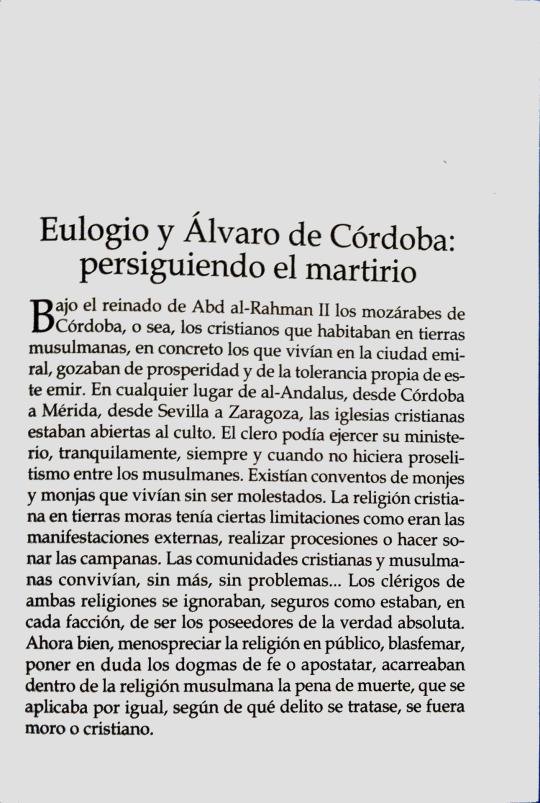
Eulogio and Álvaro de Córdoba: pursuing martyrdom
Under the reign of Abd al-Rahman II the Mozarabs of Córdoba, that is, the Christians who lived in Muslim lands, specifically those who lived in the emiral city, enjoyed prosperity and the tolerance typical of this emir. Anywhere in al-Andalus, from Córdoba to Mérida, from Seville to Zaragoza, the Christian churches were open for worship. The clergy could exercise his ministry, quietly, as long as he did not proselytize among the Muslims. There were convents of monks and nuns who lived without being bothered The Christian religion in Moorish lands had certain limitations such as the external manifestations, carrying out processions or ringing the bells. The Christian and Muslim communities lived together, without further ado, without problems... The clerics of both religions ignored each other, sure as were, in each faction, to be the possessors of the absolute truth. Now well, belittling religion in public, blaspheming, questioning dogmas of faith or apostatizing, carried within the Muslim religion the penalty of death, which was applied equally, depending on what crime it was, whether if the person was Moor or Christian.
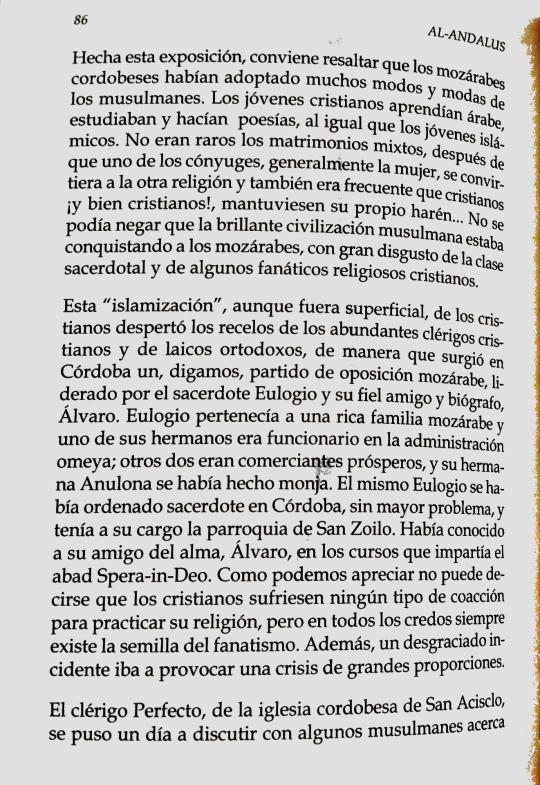
Having made this exposition, it is worth highlighting that the Mozarabs of Cordoba had adopted many ways and fashions of the Muslims. Young Christians learned Arabic, studied and wrote poetry, just like the Islamic youth. Mixed marriages were not uncommon, after one of the spouses, usually the woman, converts to the other religion and it was also common for Christians, and very Christians, to maintain their own harem... It could not be denied that the brilliant Muslim civilization was conquering the Mozarabs, to the great displeasure of the priesthood class and some Christian religious fanatics.
This "Islamization", even if it was superficial, of the Christians aroused the suspicions of the abundant Christian clerics and Orthodox laymen, of way that a, let's say, Mozarabic opposition party emerged in Córdoba, led by the priest Eulogio and his faithful friend and biographer, Álvaro. Eulogio belonged to a rich Mozarabic family and one of his brothers was official in the Umayyad administration; two others were merchants prosperous, and his sister Anulona had become a nun. Eulogius himself had been ordained a priest in Córdoba, without much problem, and had his charge of the parish of San Zoilo. He had met his soul friend, Alvaro in the courses taught by Abbot Spera-in-Deo. As we can see, It can be not said that Christians suffered type of coercion to practice their religion, but in all faiths there is always the seed of fanaticism. Furthermore, an unfortunate incident was going to cause a crisis of great proportions.
The clergyman Perfecto, from the Cordoban church of San Acisclo, one day began to argue with some Muslims about
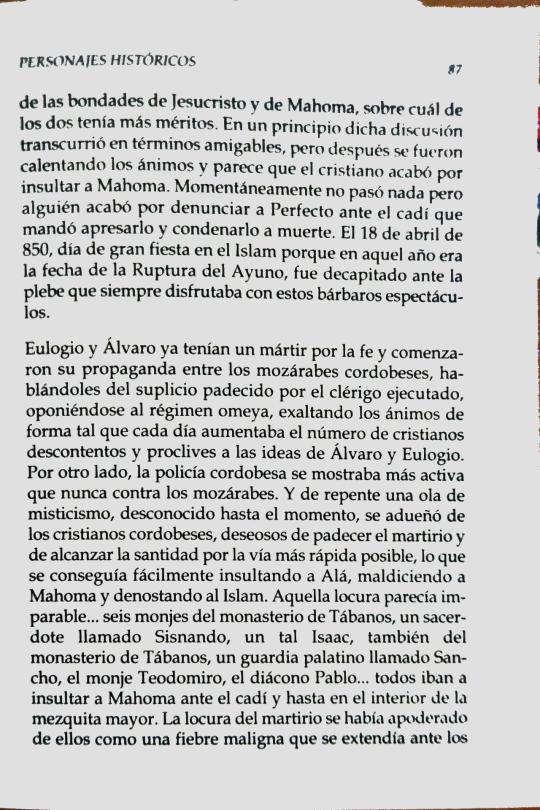
of the goodness of Jesus Christ and Muhammad, about which of the two had more merits. At first the discussion was on friendly terms, but later tempers were heating up and it seems that the Christian ended up insulting Muhammad. Momentarily nothing happened but someone ended up reporting Perfecto to the the cadi who ordered him to be arrested and sentenced to death. On April 18, 850, day of great holiday in Islam because that year was the date of the Breaking of the Fast, it was beheaded before the plebs who always enjoyed these barbaric spectacles.
Eulogio and Álvaro already had a martyr for the faith and began their propaganda among the Mozarabs of Cordoba, telling them about the torture suffered by the clergyman executed, opposing the Umayyad regime, raising spirits in such a way that every day the number of discontented Christians inclined to the ideas of Álvaro and Eulogio. On the other hand, the Córdoba police were more active than never against the Mozarabs. And suddenly a wave of mysticism, unknown until moment, took over the Christians of Cordoba, eager to suffer the martyrdom and achieving sainthood in the quickest way possible, which was achieved easily insulting Allah, cursing Muhammad and reviling Islam. That madness seemed unstoppable...six monks from the Tábanos monastery, a priest named Sisnando, a certain Isaac, also from the Tábanos monastery, a guard palatine named Sancho, the monk Teodomiro, the deacon Pablo... they all went to insulting Muhammad before the qadi and even inside the main mosque. The madness of martyrdom had taken hold of them like a malignant fever that spread before the
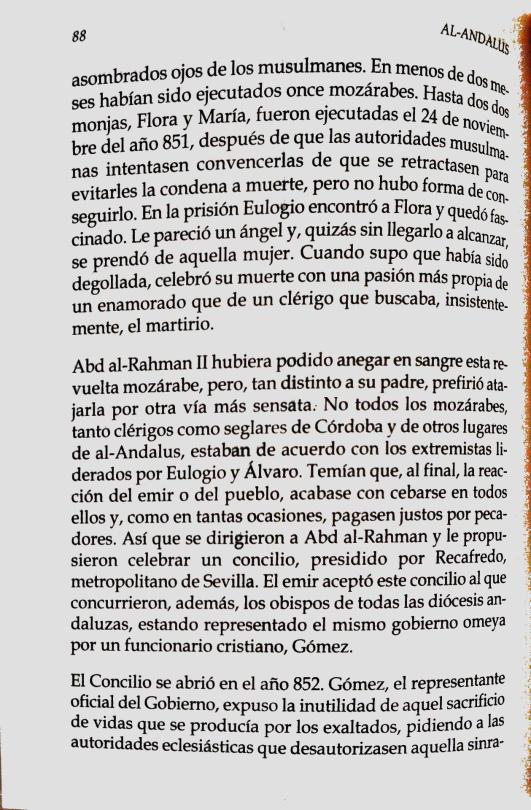
amazed eyes of the Muslims. In less than two months they had been eleven Mozarabs executed. Even two nuns, Flora and María, were executed on November 24, 851, after the Muslim authorities tried to convince them to recant to avoid the death sentence, but there was no way to achieve it. In prison Eulogio found Flora and was fascinated. It seemed like a angel and, perhaps without reaching him, he fell in love with that woman. When knew that she had been beheaded, he celebrated her death with a greater passion typical of a lover than of a clergyman who was insistently seeking, the martyrdom.
Abd al-Rahman II could have drowned this revolt in Mozarabic blood, but, so different from his father, he preferred to tackle it by another sensiblebway. Not all the Mozarabs, both clerics and laymen of Córdoba and from other places in al-Andalus, agreed with the extremists led by Eulogio and Álvaro. They feared that, in the end, the emir's reaction or the town, ended up attacking all of them and, as in so many sometimes, the righteous paid for sinners. So they approached Abd al-Rahman and proposed holding a council, presided over by Recafredo, metropolitan of Seville. The emir accepted this council to which, in addition, the bishops of all the Andalusian dioceses attended, the Umayyad government itself being represented by a Christian official, Gómez.
The Council opened in the year 852. Gómez, the official representative of the Government, exposed the futility of that sacrifice of lives that occurred by the exalted, asking the ecclesiastical authorities to disavow that non-
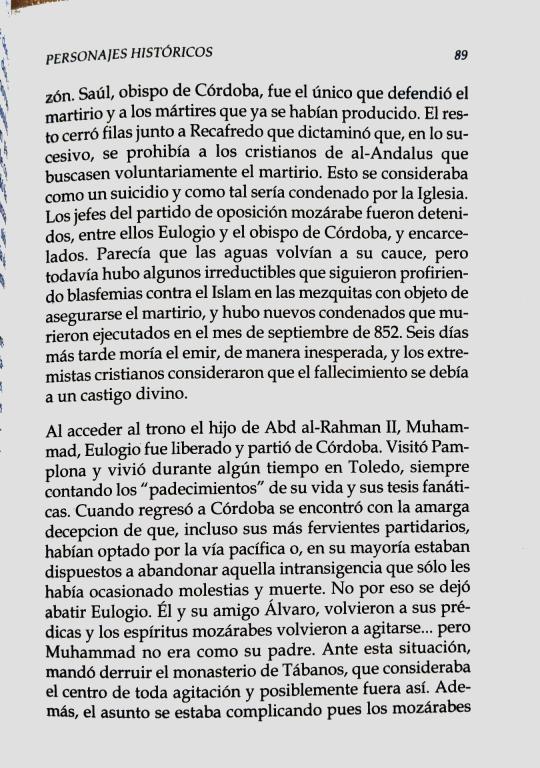
sense. Saúl, bishop of Córdoba, was the only one who defended martyrdom and the martyrs that had already occurred. The rest closed ranks with Recafredo who ruled that, from now on, the Christians of al-Andalus were prohibited from voluntarily seek martyrdom. This was considered suicide and as such he would be condemned by the Church. The leaders of the Mozarabic opposition party were arrested, among them Eulogio and the bishop of Córdoba, and imprisoned. It seemed that the waters were returning to their channel, but there was still some irreducibles who continued uttering blasphemies against Islam in the mosques in order to ensure martyrdom, and there were new convicts who were executed in the month of September 852. Six days later the emir died, unexpectedly, and the Christian extremists considered that the death was due to divine punishment.
When Abd al-Rahman II's son, Muhammad, acceded to the throne, Eulogius was released and left Córdoba. He visited Pamplona and lived for some time in Toledo, always recounting the "sufferings" of his life and his fanatical theses. When he returned to Córdoba he was met with the bitter disappointment that, even his most fervent supporters had opted for the peaceful route or, for the most part, were willing to abandon that intransigence that had only caused inconvenience and death. That's not why Eulogio let himself be discouraged. Him and his friend Álvaro, they returned to their preachings and the Mozarabic spirits stirred again... but Muhammad was not like his father. Faced with this situation, he ordered the demolition of the Tábanos monastery, which he considered the center of all unrest and possibly it was like that. Furthermore, the matter was becoming complicated because the Toledoan
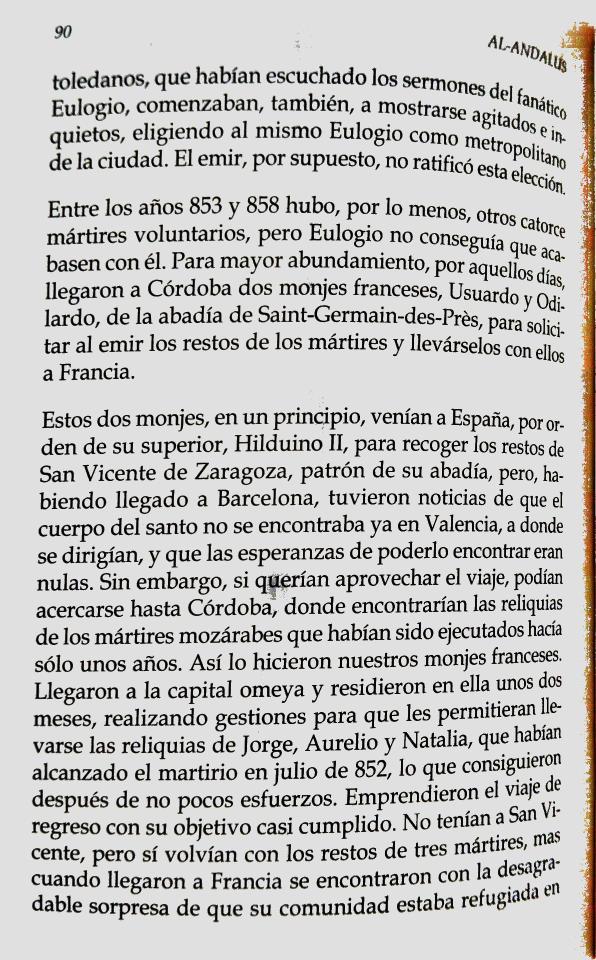
Mozarabs who had listened to the sermons of the fanatic Eulogio, were also beginning to appear agitated and restless, choosing Eulogio as metropolitan of the city. The emir, of course, did not ratified this election.
Between the years 853 and 858 there were at least fourteen other martyrs volunteers, but Eulogio couldn't get them to finish him off. For more abundance, in those days, two French monks arrived in Córdoba, Usuard and Odilard, from the abbey of Saint-Germain-des-Près, to request the remains of the martyrs from the emir and take them with them to France.
These two monks, at first, came to Spain, by order of their superior, Hildouin II, to collect the remains of S. Vicente de Zaragoza, patron of his abbey, but, having arrived in Barcelona, they had news that the saint's body was no longer in Valencia, where it was led, and that the hopes of being able to find him were zero. However, if they wanted to take advantage of the trip, they could go to Córdoba, where they found the relics of the Mozarabic martyrs who had been executed only a few years ago. This is what our French monks did. They arrived in the Umayyad capital and lived there for about two months, taking steps to allow them to take the relics of Jorge, Aurelio and Natalia, who had achieved martyrdom in July 852, what they achieved after quite a bit of effort. They started the journey back with his goal almost accomplished. They did not have S. Vicente, but they did returned with the remains of three martyrs, but when they arrived in France they found themselves with the unpleasant surprise that their community was refugee in
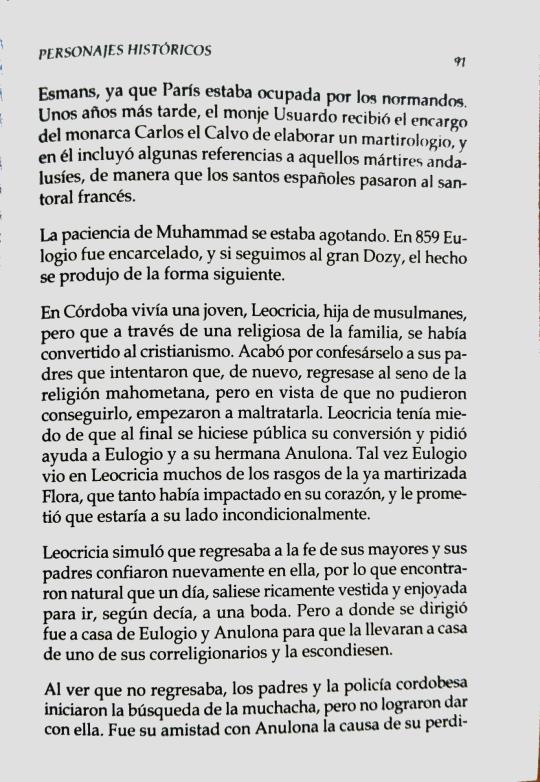
Esmans, since Paris was occupied by the Normans. A few years later, the monk Usuard received the commission from the monarch Charles the Bald to prepare a martyrology, and in it he included some references to those Andalusian martyrs, so that the Spanish saints passed to the French saints.
Muhammad's patience was wearing thin. In 859 Eulogio was imprisoned, and if we follow the great Dozy, the event occurred in the following way.
In Córdoba there lived a young woman, Leocricia, daughter of Muslims, but through a nun in the family, had converted to Christianity. She ended up confessing it to his parents who tried to get her to return to the bosom of the Mohammedan religion, but since they could not obtain it, they began to mistreat her. Leocricia was afraid that in the end her conversion would become public and asked Eulogio and his sister Anulona for help. Maybe Eulogio saw in Leocricia many of the traits of the already martyred Flora, who had so much shocked in his heart, and he promised that he would be by his side unconditionally.
Leocricia pretended to return to the faith of her elders and her parents trusted again in it, so they found it natural that one day, it would come out richly dressed and jeweled to go, as she said, to a wedding. But where she went to Eulogio and Anulona's house so they could take her to the house of one of her coreligionists and hid her.
Seeing that she did not return, the parents and the Córdoba police began the search of the girl, but they could not find her. It was his friendship with Anulona that cause of her perdi-

tion because she spent a day with her, and the servant who was to pick her up to return to her hiding place, she did not arrive until dawn. Fearing to be recognized if she went out at that time, she decided to stay one more day with her friend, until nightfall. But a spy or simply someone who knew where the fugitive was, told the cadi who sent soldiers to arrest Leocricia and Eulogio, who at that time was reaching his sister's house.
Brought before the cadi, Eulogio declared that he had taken care of instruct the young woman in Christianity in the same way as he would with the Muslim leader if he asked. Leocricia, confessed of apostasy, was sentenced to death, but Eulogio was only sentenced to be whipped.
Perhaps out of pride, Eulogio did not settle for the punishment of whipping. Everyone died before him! All his life preaching martyrdom, martyrdom that many of his supporters had suffered with joy, and he I was going to be less holy than them! It was something he couldn't consent. He was taken to the council room where one of the dignitaries who knew him since he was young, he asked him why he had such a desire to die, if there was no something in his life worth keeping. If he retracted of his continued blasphemies against Muhammad and Islam, he would be forgiven immediately.
The cultured Muslim society felt more pity than hatred for the fanatics and they also felt that they had to proceed to shed blood with those who seemed to have gone crazy. But for Eulogio there was no longer a possible retreat. If he had retracted, the contempt of his people would be even worse than death. So he stood firm
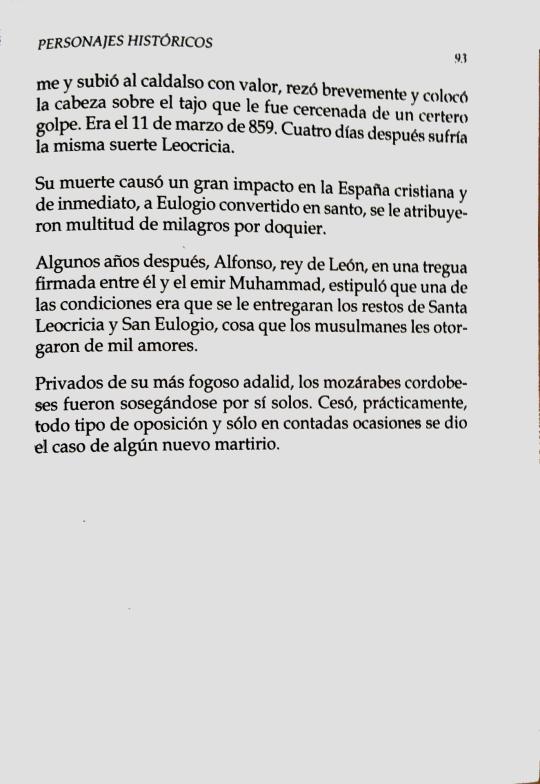
and he bravely climbed into the scaffold, prayed briefly and placed his head on the slash that was severed with a well-aimed blow. It was March 11, 859. Four days later Leocricia suffered the same fate.
His death caused a great impact in Christian Spain and immediately, Eulogio became a saint, a multitude of miracles were attributed to him everywhere.
Some years later, Alfonso, king of León, in a truce signed between him and the emir Muhammad, stipulated that one of the conditions was that the remains of S. Leocricia and S. Eulogio would be handed over, something that Muslims gave them a thousand loves.
Deprived of their most fiery champion, the Mozarabs of Córdoba were calming down on their own. Practically all types of opposition ceased and only on rare occasions there was the case of a new martyrdom.
#al andalus. historical figures#al andalus. personajes históricos#al andalus#book scans#al andalus history#bookblr#historyblr#spanish history#emirate of cordoba#eulogio de córdoba#álvaro de córdoba#emirato de córdoba
15 notes
·
View notes
Text
La missione di K.F. Butenev nell’Emirato di Bukhara: un capitolo significativo delle relazioni russo-bucarese. Esplorazioni, diplomazia e prospettive minerarie nell’Asia centrale del XIX secolo
Esplorazioni, diplomazia e prospettive minerarie nell’Asia centrale del XIX secolo. Un contesto di sviluppo economico e relazioni rafforzate.
Un contesto di sviluppo economico e relazioni rafforzate. A cavallo tra il XVIII e il XIX secolo, il Khanato di Bukhara e la Russia hanno rafforzato le loro relazioni economiche e politiche. La crescente importanza del commercio internazionale e la transizione della Russia verso un’economia capitalistica favorirono la creazione di contatti più solidi tra le due potenze. Nel 1841, su iniziativa…
#Alessandria today#commercio XIX secolo#diplomazia russa#Emir Nasrullah Khan#Emirato di Bukhara#esplorazioni russe#esplorazioni storiche#F. Bogoslovsky#fonti storiche Bukhara.#geopolitica XIX secolo#geopolitica zarista#Google News#italianewsmedia.com#K.F. Butenev#Khanato Bukhara economia#Khanato di Bukhara#missioni diplomatiche storiche#missioni russe#missioni storiche XIX secolo#monti Zarafshan#N. Khanikov#naturalista Leman#oro e argento Bukhara#Pier Carlo Lava#prigionieri russi Bukhara#rapporti Russia e Asia#relazioni economiche Russia-Bukhara#relazioni internazionali storiche#relazioni Russia e Uzbekistan#relazioni russo-bucaresi
0 notes









